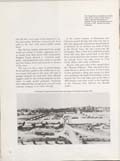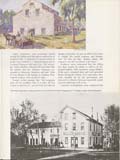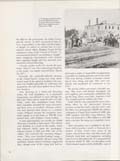
[p. 73]
The overland trails across Utah, while a windfall to the Mormons, contributed also their darkest hour of tragedy.
The tragic event is known historically as the Mountain Meadows Massacre. When smoking guns of Indians and whites ceased firing that September, 1857, upwards of 120 Arkansas and Missouri emigrants, including women and older children, lay dead in the meadows of southwestern Utah—treacherously slain.
A series of unfortunate circumstances had serious bearing on the tragedy. The Utah pioneers had learned, while celebrating the tenth anniversary of their arrival in the valley, that a federal army was approching to unseat Governor Young and control the people who allegedly were defying the U. S. government. False accusations had resulted in what became widely known as "Buchanan's Blunder," in sending troops to put down an insurrection that did not exist.
Governor Young had not been previously notifed of his ouster, nor was he aware until that July 24, that an army was on its way to Utah. Such secrecy naturally alarmed the Mormons

[p. 74]
who felt they were again being subjected to undue persecution. Had they not previously faced mobs in the East with armed militia among them?
The Mormon leaders determined the people would not submit to further oppression nor to an exodus from their newly built communities. Brigham Young decreed a "scorched earth" policy, and preparations were made to evacuate and burn houses, barns and haystacks in advance of the army.
The year was also a time of partial famine. Word had been spread to the settlements to conserve grain, feed none to the stock, sell none to passing emigrants for stock feed. Only sufficient supplies could be sold to help emigrants on elsewhere to make needed purchases. Testimony later indicated that enough grain was sold to the Arkansas company to see them through.
As the mixed company of Missourians and Arkansans passed through Salt Lake City late in July, they apparently attracted no special interest or attention, for no mention was made of them in the Deseret News, the city's seven-year old newspaper. After a false start northward around Great Salt Lake, they turned back at the Bear River and headed down the southern route, passing through Provo and other towns to Corn Creek, fifteen miles south of Fillmore.
Rumors, with some color of fact, spread about the "Missouri Wildcats". They were said to have made threats to destroy the town of Corn Creek; to have poisoned a spring and carcass of a dead cow, resulting in the death of ten Indians; to have boasted that they had taken part in the Haun's Mill Massacre and other events in the expulsion of the Mormons from Missouri two decades earlier.

[p. 75]
Anger, resentment, and excitement spread among the Indians and throughout settlements of southern Utah. A September 6 council session at Cedar City resulted in a dispatch being sent to Governor Young in Salt Lake City. The messenger, James Haslam, informed the governor that the Indians had the Arkansas emigrants surrounded at Mountain Meadows and said "John D. Lee, farmer to the Indians in southern Utah, wanted to know what should be done."
Young's verbal message that "the emigrants must not be meddled with, if it takes all Iron County to prevent it," arrived back in Cedar on Sunday, September 13, and was delivered to Isaac C. Haight. His tearful response, said Haslam, was "too late, too late." Haslam added, "the massacre was all over before I got home."
Evidence seems substantial that the killing was done largely by whites as well as by the aroused Indians. Only seventeen young children of the party remained alive and were provided homes among the settlers. Two years later, they were rounded up by the government and returned to relatives, but most reportedly ended up in an orphanage in St. Louis.
Countless investigations were conducted into

[p. 76]
the affair by the government, the Indian bureau and the church. In 1870 convinced of John D. Lee's responsibility in the affair and the neglect of Haight for failure to restrain him as Lee's superior church officer, Brigham Young led the unanimous action of the Council of Twelve to excommunicate John D. Lee and Isaac C. Haight. Some mitigating circumstances were learned later regarding Haight and Lee and both were restored to church fellowship.
A bronze marker at the site records the grim finale: John D. Lee, who confessed participation as the leader, was legally executed here, March 23, 1877."
Ironically the politically-induced invasion of the United States's troops into Utah which caused much of the agitation leading to the massacre was handled peacefully by conference and negotiation; the only blood spilled was at Mountain Meadows.